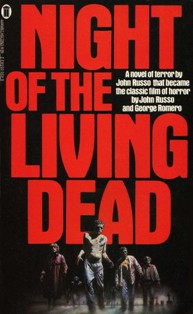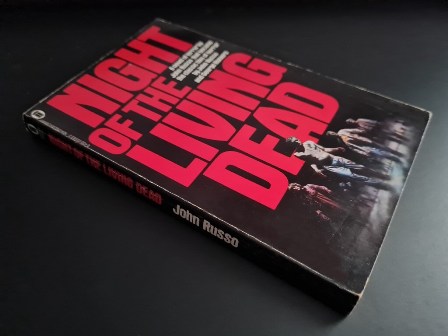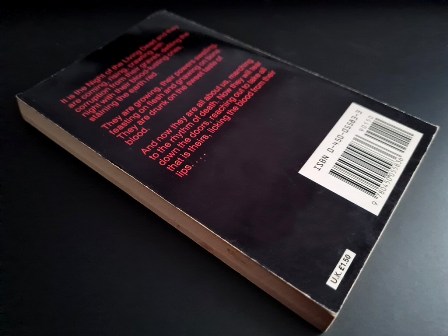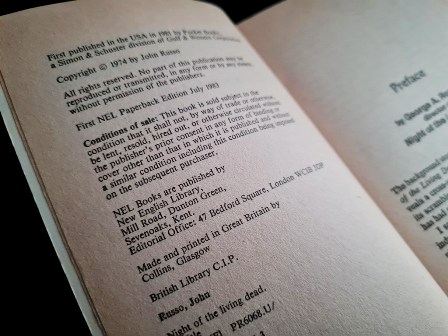
First published back in 1974, the novelisation of the 1968 cult classic film ‘Night Of The Living Dead’ was released a surprising six years after the initial release of the controversial yet highly successful movie. The novel was Russo’s debut literally release, which was later followed by a number of similarly pulp horror titles. Having co-written the screenplay alongside the legendary George A Romero, Russo was in the perfect position to extend the success of the N.O.T.L.D. franchise with the novelisation. What transpired was a too often overlooked novel that did the classic zombie movie justice, as well as adding a few additional elements of further insight into the classic storyline.
DLS Synopsis:
After driving around for over two hours, Barbra and her brother Johnny eventually manage to locate their father’s grave where they have come to place a new reef and pay their respects. The night is quickly drawing in, and as they go to leave, Barbra is attacked by a crazed stranger. Johnny wrestles with the man but is clubbed to death by the stone wielding attacker. Barbra flees to a nearby isolated house, which at first glance appears empty. By now a few more of these ‘crazed’ individuals have arrived around the property. Upon exploring the house a little further, Barbra finds the remains of an old woman, whose corpse has been savagely mutilated. In her panic, Barbra attempts to flee from the house, but is halted in her tracks by the sudden approach of a car. Out of the car climbs a black man by the name of Ben who quickly fights off the attackers that have gathered around the front of the house, and takes Barbra back inside.
Now inside, Ben begins to fortify the property by boarding up the windows and doors with whatever wood he can lay his hands on. During this, Barbra remains in a catatonic state of shock in which Ben fails to get any sort of communication from the distressed young female. Whilst boarding up the house, Ben discovers that there is a small group of individuals hiding in the property’s cellar. The party consists of a young lad by the name of Tom and his girlfriend Judy, as well as the Cooper family (Harry Cooper, his wife Helen and their seriously ill daughter Karen).
Ben already has a good idea of what is going on outside, after witnessing a series of horrific incidents that eventually led him to flee the erupting chaos on the streets and arrive at this house. However, after the group listen to the emergency radio broadcasts and the hourly emergency television broadcasts; they learn that the epidemic is far more disturbing and unbelievable that they ever would have imagined. Stunned by what they are hearing, the group can hardly believe what is being said.
The dead are returning to life and attacking the living for the consumption of their flesh. The broadcasts urge any individuals located in isolated areas, to make their way to the rescue centres that have been established all across the country. With this in mind, Ben begins to formulate a plan to get them out of this house. However, the numbers of the undead are swelling around the house with every minute that passes. A zombie siege has now started on the isolated house. And the rescue parties that the emergency broadcasts are informing people about may never get to this remote house. A decision has to be made...and quickly.
DLS Review:
‘Night Of The Living Dead’ began life as a short story written by George A Romero, as an allegory inspired by Richard Matheson’s novel ‘I Am Legend’ (1954). Romero was half the way through adapting the idea into a movie screenplay, when their film company ‘The Latent Image Inc’ (of which Romero was to be the film’s director), was ready to begin the filming process. While the team moved off to Evans City in Pennsylvania, John Russo (one of the company’s co-producers) took over the task of finishing off the scriptwriting. The end result was one of the most inspirational horror movies of all time, transcending a host of boundaries, and setting in place a new standard for which zombie films will be judged by.
After the utterly unforeseen commercial success of the film, Russo made the decision to follow-up with a novelisation that closely followed the events of the movie. Indeed, there are hardly any differences, apart from a small number of additional details that Russo has squeezed in to the story. The main one of these additions is the extra insight into the emergency rescue team, led by a Sheriff McClellan, who are making their way across the area, killing all of the undead that they encounter and rescuing any human survivors along the way. Russo dedicates a number of chapters to the progress of these groups, as well as delving into the characterisation of the principal individuals within McClellan’s party.
Although the story originally started its life as a short story, Russo’s re-writing (adapted now from the screenplay) into a full-length novel still manages to maintain a good pace, with the tension never having chance to let up. Admittedly, the novel is not a fast-paced, action-packed ripper of a book; but Russo has kept true to the original story and delivered a powerfully written version of the classic zombie siege.
The characterization is adequately developed, with each personality appropriately fleshed-out. Harry Cooper is still just as cowardly and obnoxious, but now we are given small glimpses of the traumatic scenario from behind his own eyes. Furthermore, Barbra’s desperate reaction to the undead attackers and the resulting catatonic state is transferred to the pages well.
Russo’s breakdown of the novel into the various chapters is a little haphazard to say the least. The book contains a total of twenty-two chapters, although the first half of the book is divided up into just four chapters. This leaves the remaining half of the book to be broken up into eighteen odd chapters. Furthermore, the closer the reader seems to get to the end of the book, the shorter the chapters appear to be (roughly speaking). This may or may not be a purposeful concept for the novel, but it does cause the reader to wonder at the reasons behind such an odd format within the structuring of the book.
All in all, the novel does the 1968 film absolute justice, offering up a little extra insight into the details of the story, whilst still staying true to the original storyline. The few characters involved are full-bodied and proportionately fleshed-out, depending on their individual importance to the plot (i.e. less time is spent developing the characters, such as with the likes of Helen Cooper and her daughter etc). A thoroughly enjoyable read and one that should not be overlooked by zombie and horror fans alike.
The book also contains a ten page preface by George A Romero, in which he writes about the history of the story, detailing the filming process as well as talking about the ideas and principles behind the story (and dispelling a few notions from its over-analysis). The novel was later followed up with the sequel ‘Return Of The Living Dead’ (1978) which Russo also penned.
The novel runs for a total of 176 pages (including the forward).
© DLS Reviews









